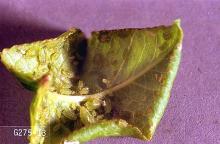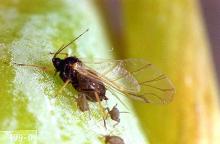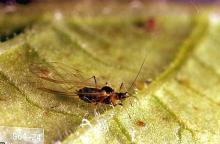Includes
Bean aphid (Aphis fabae)
Green peach aphid (Myzus persicae)
Pea aphid (Acyrthosiphon pisum)
Potato aphid (Macrosyphum euphorbiae)
Pest description, crop damage and life history
See:
Common Pests of Vegetable Crops
Management-biological control
Many parasitoids and predators attack aphids. Early season aphids have many natural enemies that frequently bring them under control later in the year. Among the more common predators are lady beetles and their larvae, lacewing larvae, and syrphid fly larvae. Populations of green peach aphids are reduced in winter by the insect pathogenic fungus Entomophthora aphidis.
Monitor the proportion of aphid mummies relative to unparasitized aphids and the numbers of predators such as lady beetles. If the proportion of mummies is increasing, or predators appear to be gaining control, and aphid populations are not yet damaging, avoid sprays that will disrupt these natural enemies. Most materials available for aphid control are highly disruptive of natural enemy populations.
Management-cultural control
Destroy infested crops immediately after harvest to prevent dispersal. Destroying weed hosts late in the year may help destroy overwintering populations. Aphid populations tend to be higher in crops that are fertilized liberally with nitrogen. Roguing diseased plants early may help slow the spread of aphid-vectored diseases. Home gardeners can often get effective control by washing aphids with a strong stream of water.
Management-chemical control: HOME USE
Apply to both tops and undersides of leaves.
- acetamiprid
- azadirachtin (neem oil)-Some formulations are OMRI-listed for organic use.
- bifenthrin (usually as a mix with zeta-cypermethrin)
- malathion
- plant essential oils (rosemary, etc.)-Some formulations are OMRI-listed for organic use.
- pyrethrins (often combined with other ingredients)-Some formulations are OMRI-listed for organic use.
- zeta-cypermethrin
Management-chemical control: COMMERCIAL USE
- acephate (numerous products) at 0.5 to 1 lb ai/A. PHI 14 days, 1 days for lima beans harvested in succulent form. REI 24 hr. Do not feed treated vines. Do not exceed 2 lb ai/A per year.
- acetamiprid (Assail 30SG) at 0.047 to 0.1 lb ai/A. PHI 7 days. REI 12 hr. Retreatment interval 7 days. Limit 3 applications per season. Do not exceed 0.3 lb ai/A per season.
- Beauveria bassiana (Mycotrol ESO) at 0.25 to 1 quart/A. PHI 0 days. REI after 4h. Some formulations are OMRI-listed for organic use.
- bifenthrin (Brigade, Sniper) at 0.033 to 0.1 lb ai/A. PHI 14 days. REI 12 hr. Do not exceed 0.3 lb ai/A per year. Do not apply within 25 ft of an aquatic habitat, 150 ft if applied by air.
- dimethoate (numerous products) at 0.25 to 0.5 lb ai/A. PHI 0 days when harvested mechanically. REI 48 hr. Do not feed treated vines.
- esfenvalerate (Asana XL) at 0.03 to 0.05 lb ai/A. PHI 21 days. REI 12 hr. Do not exceed 0.2 lb ai/A per season. Dry beans only.
- flupyradifurone (Sivanto 200 SL) at 7 to 10.5 fl oz/A. PHI 21 days. REI 4 hr. Do not exceed 0.365 lb ai/A per year. Minimum of 10 days between successive applications. Washington only.
- imidacloprid (Admire Pro) at 0.25 to 0.375 lb ai/A soil applied only. PHI 21 days. REI 12 hr. Do not exceed 0.375 lb ai/A per season. Do not apply within 25 ft of an aquatic habitat.
- lambda-cyhalothrin (Warrior II) at 0.02 to 0.03 lb ai/A. PHI 7 days for green beans, 21 days for dry beans. REI 24 hr. Do not feed to or graze livestock. Do not exceed 0.12 lb ai/A per year. Do not apply within 25 ft of an aquatic habitat, 150 ft if applied by air. Washington only.
- methomyl (Lannate LV) at 0.45 to 0.9 lb ai/A. PHI 1 to 3 days for succulent beans, 14 days for dry beans, 3 days for feeding vines, 7 days for hay. REI 48 hr. Do not exceed 4.5 lb ai/A per season.
- naled (Dibrom 8) at 0.94 lb ai/A. PHI 1 day. REI 48 hr. Do not apply within 25 ft of an aquatic habitat, 150 ft if applied by air.
- phorate (Thimet 20_G)-Do not exceed 1.5 lb ai/A. PHI 60 days. REI 48 hr, or 72 hr if annual rainfall is less than 25 inches. Apply at planting. Do not graze or feed to livestock. Toxic to fish and wildlife.
- spirotetremat (Movento HL) at 2.5 fl oz/A. PHI 7 days. Retreatment interval 7 days. REI 24 hr. Washington only.
- sulfoxaflor (Transform WG) at 0.75 to 1.0 oz/A. Do not exceed 8.5 oz/A. PHI 7 days. REI 24 hr. If blooming vegetation is present 12 ft out from the downwind edge of the field, a 12 foot in-field down wind buffer must be observed.
- zeta-cypermethrin (Mustang Maxx; Mustang) at 0.02 to 0.025 lb/A (Mustang Maxx) or 0.04 to 0.05 lb ai/A (Mustang). PHI 21 days. REI 12 hr. Retreatment interval 5 days. Do not exceed 0.15 lb ai/A (Mustang Maxx) or 0.3 lb ai/A Mustang per season. Do not apply within 25 ft of an aquatic habitat by ground application, or 150 ft if applied by air.





